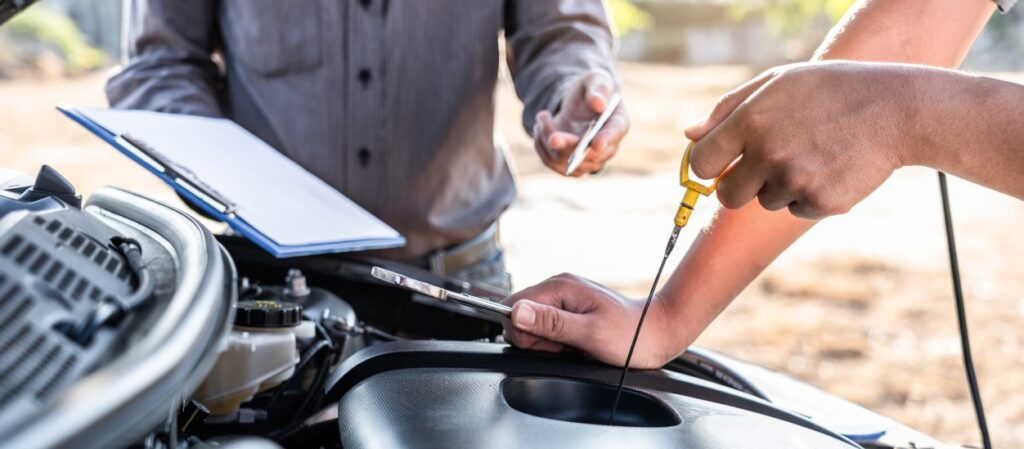

Driving Performance Evaluation Score Explained: Here is what you need to know before taking the driving test. The California Department of Motor Vehicles (DMV) uses a driving evaluation system to measure your ability as a driver and assign you a score. This is done through the use of two components, a pre-driving check list and on-road driving observation. On the test day, an examiner will carry a Performance Evaluation Score Sheet and will tick marks on this sheet before and after your evaluation. There is a long article about it on the official DMV website, but it is hard to comprehend every aspect easily because the documentation is very complex. So we made a summary of this criterion for you. Keep reading…

Pre-Drive Checklist items are as follows:
The window on the driver’s side must open. Your examiner will ask you to open the window if the window is closed. The windshield must provide a full unobstructed field of view for you and the examiner. Your vehicle must have at least two mirrors. One must be located outside on the left side of the vehicle.
The other mirror may be located inside in the center or outside on the right side of the vehicle. Mirrors must be secure, unbroken, and provide clear visibility.
Both right and left turn signals on the front and back of the vehicle must be operational. Both brake lights must be fully functional.
There must be at least an inch of clearance between the pedal and the floorboard when the pedal is depressed. The horn must be designed for the vehicle and in proper working condition.
Your driving test will be rescheduled as a mechanical failure if your parking brake does not work or if the brake does not set during the check.
During inclement weather, the driver must demonstrate that
items 11-14 work correctly, or the driving test will be rescheduled.
The following scoring criteria are DMV’s standard for evaluating an applicant’s driving ability. All driving test examiners use these criteria to assess noncommercial Class C driving tests.
A “traffic check” is both vehicle and pedestrian traffic observation and the proper reaction to the traffic. The examiner, in every action, observes it.
These criteria are used to evaluate your ability while driving
through a parking lot.
You observe traffic head and behind you, to the left and right, and you yield the right-of-way to vehicles, bicyclists, and pedestrians when necessary for safety. You turn your head and look toward other drivers,
bicyclists, and pedestrians when necessary. You react safely to traffic situations. You drive through the parking lot at a safe speed and are in control of the vehicle.
These criteria are used to evaluate your action or inaction during a
driving test that would result in a driving test failure.
Intervention by the examiner means any action or inaction that requires physical or verbal intervention by the examiner. An example of a verbal intervention could be the examiner loudly stating. “Stop.” You make three attempts to hack your vehicle.
You contact another vehicle, object, bicyclist, pedestrian. or animal when it could have been safely avoided. You drive over the curb or on the sidewalk.
If you go through or exceed a brisk walking speed (4 mph) at a stop sign.
Flashing red light, right turn on a red light, if you do not stop and wait for a green signal at a red light or you make an unnecessary stop at a green light or on a freeway-metered ramp or disobey other traffic signs and lane marking,
For example, you pass a school bus that has flashing red lights. Traffic in both directions must stop unless driving on a divided highway. You fail to pull over and stop for an emergency vehicle. You disobey any safety personnel, law enforcement officer, or firefighter.
What are the dangerous maneuvers. Here is the list:
6. If you stall the engine:
Suppose you drive ten mph or over the speed limit or under the speed limit when the road, pedestrians, bicyclists, or traffic conditions do not warrant a lower speed. You drive too fast for safety or slow for safety.
Failure to use the windshield wipers, defroster, or headlights
when weather conditions or darkness requires the use of
Or if you turn from a designated forward lane.
If You make a turn from the wrong lane.
Driving tests are given to first-time Driver License applicants and other individuals who should take a driving test. The purpose of a driving test is to determine whether you:
It can make up for any physical condition, such as losing a limb, poor hearing, or vision.
The driving test is divided into the Pre-Drive Safety Check and Driving Performance Evaluation (DPE).
The Pre-Drive Safety Check determines whether your vehicle meets the DMV minimum safety standard and whether you are familiar with the operation of your car. The DPE portion is the behind-the-wheel driving test when you drive your car with a DMV examiner who evaluates your driving skills.
You can download DMV’s official documentation by clicking here.